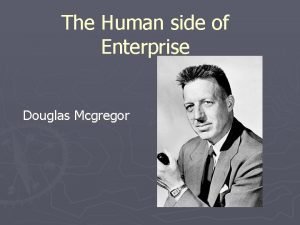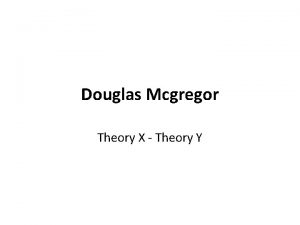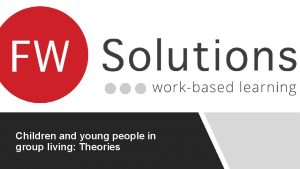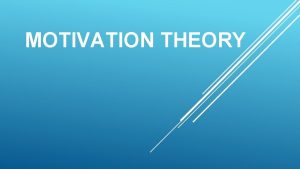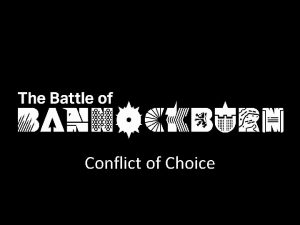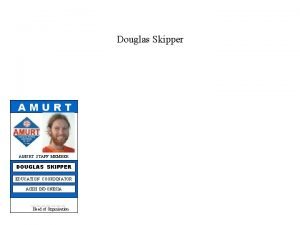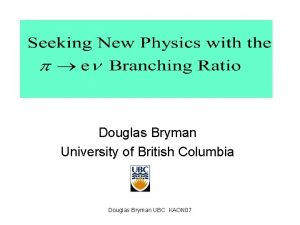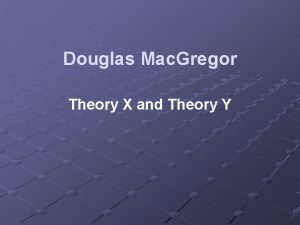Douglas Mcgregor Theory X Theory Y The Human



























- Slides: 27

Douglas Mcgregor Theory X - Theory Y

The Human Side Of Enterprise • Douglas Mcgregor proposed two theories by which to view employee motivation.

Theory X And Theory Y Both of these theories begin with the premise that … • Management's role is to assemble the factors of production including people for the economic benefit of the firm. • Beyond this point the two theories of management diverge.

Theory X assumes that the average person: • dislikes work and attempts to avoid it • has no ambition • wants no responsibility • would rather follow than lead • is self centered and therefore does not care about organizational goals • resists change • is gullible and not particularly intelligent • works only for money and security

Theory X - The Hard And Soft Approach • Under theory x management, approaches can range from a hard approach to a soft approach.

The Hard Approach relies on … • coercion • implicit threats • close supervision • tight controls • essentially an environment of command control.

The Soft Approach • Permissive • seek harmony • hope that in return employees will cooperate when asked to do so

Neither Of These Extremes Is Optimal The hard approach results in … • hostility • purposely low output • hard line union demands.

Neither Of These Extremes Is Optimal The soft approach results in … • ever increasing requests for more rewards in exchange for • ever decreasing work output.

The Optimal Management Approach • probably would be somewhere between these extremes However … • Mcgregor asserts that neither of these approaches is appropriate because the assumptions of Theory X are not correct.

The Problem With Theory X Drawing on Maslow's hierarchy … • Mcgregor argues that a satisfied need no longer motivates

The Problem With Theory X • The firm relies on money and benefits to satisfy employees' lower needs • Once these needs are satisfied the source of the motivation is lost. • Theory x management styles hinder the satisfaction of higher level needs.

The Problem With Theory X • The only way employees can attempt to satisfy their higher level needs is by seeking more compensation • it is quite predictable that they will focus on monetary rewards. • While money may not be the most effective way to self fulfillment, in a theory x environment it may be the only way.

The Problem With Theory X • People use work to satisfy their lower needs • People seek to satisfy their higher needs in their leisure time

The Problem With Theory X • Mcgregor makes the point that … • a command control environment is not effective because it relies on the lower needs as levers of motivation but • in modern society those needs are already satisfied and thus are no longer motivators.

The Problem With Theory X In this situation expect employees to … • dislike their work • avoid responsibility • have no interest in organizational goals • resist change • thus making Theory X a self fulfilling prophecy.

Theory Y • The higher level needs of self esteem and selfactualization are continuing needs in that they are never completely satisfied.

Theory Y • It is the higher level needs through which employees can be motivated.

Theory Y Makes the following general assumptions: • Work can be as natural as play and rest. • People will be self directed to meet their work objectives if they are committed to them. • People will be committed to their objectives if rewards are in place that address higher needs such as self fulfillment.

Theory Y • People will seek responsibility. • Most people can handle responsibility because creativity and ingenuity are common in the population.

Theory Y • There is an opportunity to align personal goals with organizational goals by using the employees' own quest for fulfillment as the motivator.

Theory Y • Mcgregor recognized that some people may not have reached the level of maturity assumed by Theory Y and therefore may need tighter controls that can be relaxed as the employee develops.

Theory Y Implications the firm can do many things to harness the motivational energy of the employees: • Decentralization and delegation – If firms decentralize control and reduce the number of levels of management, each manager will have more subordinates and consequently will be forced to delegate some responsibility and decision making to them.

Theory Y Implications The firm can do many things to harness the motivational energy of the employees: • Job enlargement – Broadening the scope of an employee's job adds variety and opportunities to satisfy ego needs.

Theory Y Implications The firm can do many things to harness the motivational energy of the employees: • Participative management – Consulting employees in the decision making process taps their creative capacity and provides them with some control over their work environment.

Theory Y Implications The firm can do many things to harness the motivational energy of the employees: • Performance appraisals – Having the employee set objectives and participate in the process of evaluating how well they were met.

Theory Y Implications The firm can do many things to harness the motivational energy of the employees: • such an environment would result in a high level of motivation as employees work to satisfy their higher level personal needs through their jobs.
 Douglas mcgregor the human side of enterprise
Douglas mcgregor the human side of enterprise Theory x and y douglas mcgregor
Theory x and y douglas mcgregor Douglas mcgregor teori x dan y
Douglas mcgregor teori x dan y Herzberg and mcgregor's motivation theory
Herzberg and mcgregor's motivation theory Nia magoulianiti-mcgregor
Nia magoulianiti-mcgregor Mcgregor
Mcgregor Douglas theory on group living
Douglas theory on group living Hình ảnh bộ gõ cơ thể búng tay
Hình ảnh bộ gõ cơ thể búng tay Slidetodoc
Slidetodoc Bổ thể
Bổ thể Tỉ lệ cơ thể trẻ em
Tỉ lệ cơ thể trẻ em Voi kéo gỗ như thế nào
Voi kéo gỗ như thế nào Glasgow thang điểm
Glasgow thang điểm Chúa yêu trần thế alleluia
Chúa yêu trần thế alleluia Các môn thể thao bắt đầu bằng tiếng bóng
Các môn thể thao bắt đầu bằng tiếng bóng Thế nào là hệ số cao nhất
Thế nào là hệ số cao nhất Các châu lục và đại dương trên thế giới
Các châu lục và đại dương trên thế giới Cong thức tính động năng
Cong thức tính động năng Trời xanh đây là của chúng ta thể thơ
Trời xanh đây là của chúng ta thể thơ Cách giải mật thư tọa độ
Cách giải mật thư tọa độ Phép trừ bù
Phép trừ bù Phản ứng thế ankan
Phản ứng thế ankan Các châu lục và đại dương trên thế giới
Các châu lục và đại dương trên thế giới Thơ thất ngôn tứ tuyệt đường luật
Thơ thất ngôn tứ tuyệt đường luật Quá trình desamine hóa có thể tạo ra
Quá trình desamine hóa có thể tạo ra Một số thể thơ truyền thống
Một số thể thơ truyền thống Cái miệng nó xinh thế
Cái miệng nó xinh thế Vẽ hình chiếu vuông góc của vật thể sau
Vẽ hình chiếu vuông góc của vật thể sau
